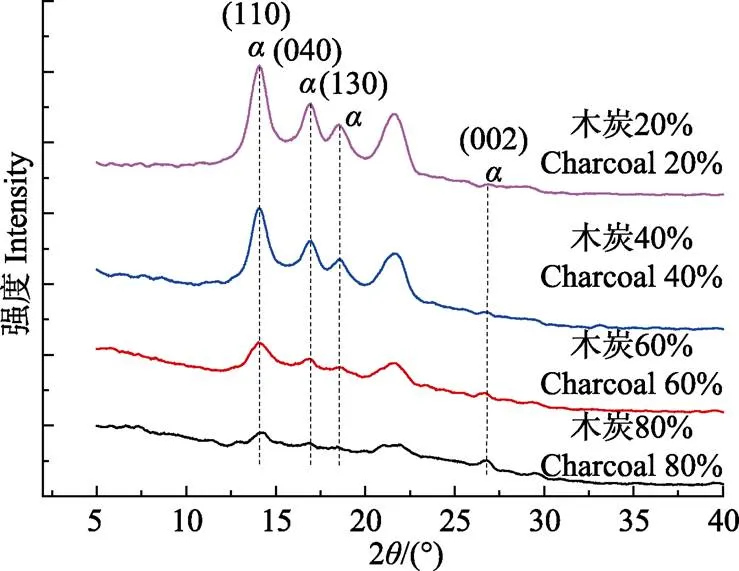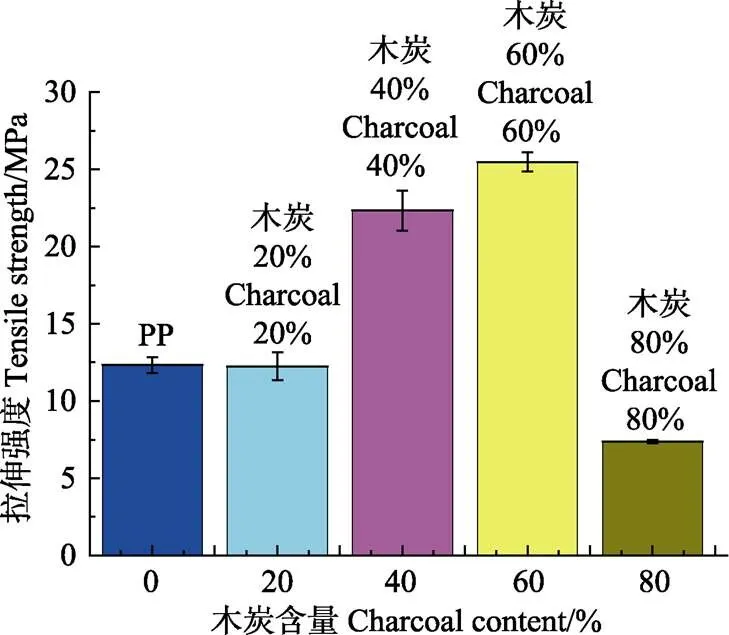含炭量对木炭/聚丙烯复合材料性能的影响
2018-11-23张庆法蔡红珍张继兵易维明
张庆法,蔡红珍,周 亮,张继兵,易维明※
含炭量对木炭/聚丙烯复合材料性能的影响
张庆法1,2,蔡红珍1,2,周 亮1,2,张继兵3,易维明1,2※
(1. 山东理工大学农业工程与食品科学学院,淄博 255000;2. 山东省清洁能源工程技术研究中心,淄博 255000; 3. 安徽爱乐门窗系统工程有限公司,宿州 234000)
为了改善聚丙烯(polypropylene, PP)的力学性能,该文以木炭、聚丙烯(polypropylene, PP)为主要原料,采用双螺杆挤出机制备木炭/PP复合材料。并利用X射线衍射仪(X-ray diffractometer, XRD)、差式扫描量热仪(differential scanning calorimeter, DSC)、电子万能力学试验机、动态热机械分析仪(dynamic mechanical analyzer, DMA)、场发射扫描电镜(scanning electron microscope, SEM)等仪器对复合材料进行性能特性的表征分析。试验结果表明,PP基体在高温下以流体的形式流入木炭的孔隙,并与木炭相互缠绕、粘结,形成一种界面较为致密的结构,这种结构使得复合材料具有较好的静态力学性能(拉伸强度最高为25.47 MPa)与动态力学性能(储能模量最高为4 921.92 MPa)。研究结果可为木炭在生物基材料方面的应用提供新的思路。
复合材料;聚丙烯;炭化;力学性能
0 引 言
以天然纤维(木粉、秸秆粉、竹粉等)和热塑性塑料(聚乙烯、聚丙烯、聚氯乙烯等)为主要原料,采用熔融挤出或者模压的成型方式加工制得的复合材料(木塑复合材料)不仅兼有木材的质感和塑料的优势,同时也为农林业废弃物与废旧塑料的回收利用提供了一种新思路。作为一种绿色环保材料,木塑复合材料凭借其低廉的成本和较好的强度被广泛应用于室内室外装饰装修、交通、汽车等领域[2-8]。但是,天然纤维材料表面存在大量亲水性极性基团,而热塑性塑料又是非极性属性,两者结合性极差,致使材料内部产生大量空隙,较差的界面结合也是复合材料力学性能较差的最重要原因之一[9]。为此,许多专家学者在提高木塑复合材料强度方面做了大量的研究工作。赵剑英等[10]利用丙烯酸酯共聚物增容剂对木塑复合材料进行增容,使得木塑复合材料的拉伸强度提高了2.2倍;于旻等[11]采用复合处理法对麦秸秆纤维进行表面处理后制备木塑复合材料,结果表明:复合处理麦秸秆后制备的木塑复合材料力学性能要优于单纯使用偶联剂处理麦秸秆制备的木塑复合材料;潘明珠等[12]利用聚磷酸铵改善稻秸-高密度聚乙烯复合材料的理化性能,研究发现聚磷酸铵可有效改善木塑复合材料的韧性。除此之外,还有部分学者通过利用其它填料代替天然纤维的方式来增强复合材料的强度。张庆法等[13]利用稻壳炭代替稻壳制备复合材料并与稻壳/高密度聚乙烯(HDPE)复合材料进行对比分析,结果发现稻壳炭填充热塑性塑料复合材料具有更强的力学性能;Ning[14]利用碳纤维增强塑料制备复合材料,该材料具有良好的拉伸性能。
木炭的使用由来已久,随着经济的高速发展,其需求量也不断增大,木炭被广泛应用于食品、制药、化工、冶金、国防、农业及环境保护等诸多领域[15],与木材等天然纤维相比,木炭由木材在高温下热解炭化得到,在炭化过程中,木材表面的极性基团受到高温影响被破坏,本身极性较低[16],更容易与非极性或弱极性的热塑性塑料相容,不存在界面结合很差[17]的问题。但是,作为生物炭的一种,木炭在代替天然纤维增强热塑性塑料制备复合材料方面的研究才刚刚起步,研究空间十分巨大。Das等[18]在木塑复合材料中加入木材热解炭用以开辟生物炭的利用途径,试验表明该复合材料具有良好的力学性能和阻燃性能。Li等[19]利用木炭改性超高分子量聚乙烯制备复合材料,该材料不仅具有极好的力学性能还有较佳的导电性。以上学者对木炭在生物基材料方面的应用进行了深入研究,并取得了一定的进展。但是上述研究所采用的偶联剂、超高分子量聚乙烯等原料成本较高,在一定程度上限制了该材料的应用。本文以木炭为填料、较为廉价的PP为基体,采用挤出法制备木炭/PP复合材料,通过利用XRD、DSC、抗拉伸测试、DMA、SEM等先进手段对复合材料进行表征测试分析,为木炭在生物基材料方面的应用提供有益的借鉴经验。
1 材料与方法
1.1 试验材料
木炭:市售土窑木炭,60目,济南富吉化工有限公司;PP:SMS-514F,熔融指数为3.2 g/10 min,密度为0.9 g/cm3,熔点为190~200 ℃,上海意恩塑化有限公司;钙锌复合稳定剂为硬脂酸钙和硬脂酸锌复合稳定剂,其中硬脂酸钙和硬脂酸锌的摩尔比为2:1,邵阳天堂助剂化工有限公司;润滑剂,TPW613,美国Struktol公司。
1.2 木炭/PP复合材料的制备
将木炭敲成小块置于超细粉碎机内粉碎成粉状并过80目筛,然后将粉状木炭置于鼓风干燥箱(DHG-9620A,上海一恒科技仪器有限公司)内干燥24 h,温度设定为105 ℃,使其质量含水率降至2%以下;然后将干燥后的木炭(20%,40%,60%,80%)、PP(70%,50%,30%,10%)、钙锌复合稳定剂(6%)、润滑剂(4%)置于双运动三维高速混合机(JHN-15,郑州金泰金属材料有限公司)中充分混合10 min,得到均匀混料;将均匀混料投入到双螺杆挤出机(BP-8177-ZB,东莞市宝品精密仪器有限公司)中进行挤出造粒得到粒料;将所得粒料再次投入到双螺杆挤出机中进行二次挤出成型,挤出机转速为40 r/min,挤出温度为200~220 ℃。
1.3 性能测试
XRD分析:利用X射线衍射仪(Bruker AXS D8 Advance,德国 Bruker AXS有限公司)对复合材料试样进行XRD分析,操作电压为 40 kV,电流为50 mA,扫描范围为5°~40°,扫描速度为5°/min;
DSC分析:利用差示扫描量热仪(Q100-DSC,美国TA有限公司)对复合材料样品进行DSC分析,取样5~10 mg,在氮气气氛下以5 ℃/min的升温速率升至180 ℃,然后再以同样的速率冷却至80 ℃。
拉伸强度测试:拉伸强度通过电子万能试验机(WDW1020,长春科新公司)测试,将复合材料样品用多功能切割台锯(WMT-10TS,浙江华丰电动工具有限公司)切割成180 mm×10 mm×4 mm待测,拉伸速率为10 mm/min。取5次平均值作为测试结果。
动态热机械分析:利用动态热机械分析仪(Q800,美国TA有限公司)进行动态热机械分析,试验选取双悬臂模式,试样尺寸为60 mm×10 mm×3 mm,扫描频率为5 Hz,试验温度范围设置为–30~160 ℃,升温速率为5 ℃/min。
微观结构:对木炭粉末以及复合材料拉伸断面进行喷金处理后利用场发射扫描电镜(Sirion 200,美国FEI有限公司)观察微观形貌,扫描电压为3.0 kV。
2 结果与分析
2.1 木炭/PP复合材料X射线衍射分析
图1为不同木炭含量的木炭/PP复合材料XRD曲线图。从图1中可以看出,木炭/PP复合材料的XRD曲线的变化基本保持一致,且图线的形状趋势跟纯PP的XRD图线基本一致[20]。不同木炭含量的复合材料在14°、17°、18°以及27°有明显的峰,这些峰分别对应于晶面(110)、(040)、(130)、(002),表现为晶型,完全符合PP的半结晶性质。说明复合材料中所有的结晶峰都是PP引起的,木炭并没有对复合材料的衍射峰做出贡献,同时也说明木炭的本质属于非晶态[21]。值得注意的是,随着木炭含量的增加,所有样品的峰强度都相应降低,这是因为大量非晶态木炭导致复合材料中晶态材料的缺乏,进而导致复合材料XRD衍射峰强度降低[22]。综上所述,木炭/PP复合材料跟PP一样是部分结晶,木炭含量的变化对复合材料的衍射峰强度具有重要影响,但对复合材料的微晶结构影响不大。

图1 不同木炭含量的木炭/PP复合材料XRD曲线
2.2 木炭/PP复合材料DSC分析
图2为PP以及不同木炭含量的木炭/PP复合材料DSC曲线图。由图2可知,纯PP在165 ℃时开始吸热并进入熔化阶段。当PP中添加木炭时,复合材料的熔融温度依然保持在165 ℃左右,基本保持不变。但是随着木炭含量的增加,复合材料熔化所需的能量随之增加了,这是因为PP基复合材料中添加了热稳定性较强的木炭。另一方面,纯PP在118 ℃开始放热并进入结晶成型阶段,与木炭/PP复合材料的熔融温度不同的是,当PP中加入木炭时,复合材料的结晶温度明显升高,且木炭含量越高,结晶温度越高。这可能是由于PP基体中的木炭粒子的成核效应所致,木炭粒子成为了晶体生长的起始点。这同时也说明,木炭含量的增加有利于复合材料的早期结晶。另外,从图2中还可以看出,随着木炭含量的增加,结晶峰的强度在逐渐减小,这说明木炭含量越高,复合材料结晶所需要的能量越少,这再次说明木炭含量的增加对复合材料的结晶是有利的。
2.3 木炭/PP复合材料拉伸强度
图3为不同木炭含量下的木炭/PP复合材料拉伸强度图。由图3可知,木炭含量对复合材料的拉伸强度影响比较大。当木炭含量为20 %时,木炭/PP复合材料的拉伸强度较低,只有12 MPa,几乎接近纯PP,此时复合材料的主要成分为PP,较少的木炭颗粒被分散在PP基体内部的各处,木炭颗粒之间的间距较大,木炭起不到增强作用。当木炭含量达到60 %时,复合材料的拉伸强度为25.47 MPa,达到最大值。木炭由木材高温炭化得到,跟木材相比,木炭本身所具有的极性基团的含量较低,与非极性的PP之间的排斥作用也比较弱,且此时木炭与PP的含量相当,两者混合最为均匀、充分,结合最为紧密,木炭颗粒之间的间距适中,复合材料界面最优[20]。值得注意的是,随着木炭含量增加到80 %,复合材料的拉伸强度大幅度下降至7 MPa,PP在复合材料内部起到一个粘结剂的作用[23],将不同的木炭颗粒粘结到一起。此时木炭的含量远远超过了PP,含量极为有限的PP,不能有效地将木炭颗粒粘结到一起,木炭在PP中形成大量团聚,复合材料的结合界面被严重破坏,当受到外力时,极易产生应力集中,所以木炭/PP复合材料的拉伸强度大幅度下降至7 MPa。从分子结构层面讲,与PE相比,PP主链上含有侧基-CH3,其高分子链的空间位阻比PE大,不利于高分子链的内旋转,使链的刚性增加,柔顺性降低;PE分子链规整性比PP高,结晶度也高于PP[24],所以在高填充量(80 %)时PE基体的复合材料可以获得高的拉伸强度,而PP基体的复合材料则无法获得。

图2 不同木炭含量的木炭/PP复合材料DSC曲线

图3 不同木炭含量的木炭/PP复合材料的拉伸强度
2.4 木炭/PP复合材料的动态力学分析
动态力学分析可反映复合材料界面性能的优劣,亦可反映材料的结构、组分间的相容性和分子运动能,与静态力学相比,更能客观反映材料在实际使用时的基本性能[25-27]。图4为不同木炭含量下木炭/PP复合材料的储能模量()与损耗因子(tan)。由图4可知,当温度较低时,复合材料的储能模量较大,但是随着温度的升高,复合材料储能模量不断下降,这是因为温度较低时,木炭/PP复合材料分子运动量较小,刚性较大。而随着温度的升高,直到达到复合材料的玻璃转化点后,PP本身的热塑性降低,复合材料的刚性也随之降低。由图4还可以看出,随着温度的升高,5种复合材料的损耗因子tan都呈现出逐渐上升的趋势,这是因为温度的升高加剧了木炭/PP复合材料内部的热运动,PP分子链的可滑动性增加,表现为复合材料柔性的增加[28]。图4中还可以看出木炭含量对复合材料与tan的影响规律。在–25 ℃时,5种复合材料的都达到最大值,纯PP的仅为2 380.33 MPa,随着木炭含量的增加,木炭/PP复合材料的不断增大,当含炭量达到80 %时,复合材料的高达4 921.92 MPa,木炭起到了刚性增强作用,木炭与PP在熔融状态下混合成型之后,木炭的骨架结构[29]在PP基体中起到增强作用,而这种骨架同时限制住了PP基体的流动,起到了一种阻碍作用,木炭含量越高,这种阻碍作用越大,复合材料的刚性就越强。而从损耗因子曲线上可以看出,随着木炭含量的增加,复合材料的tan不断下降,这表明木炭的增加有利于增强复合材料的弹性[30]。这是因为木炭阻碍了PP基体链段的运动,从而影响了复合材料的阻尼特性,所以木炭含量越高,复合材料弹性越好。

图4 不同木炭含量的木炭/PP复合材料的储能模量和损耗因子
2.5 木炭及木炭/PP复合材料的微观结构分析
图5为木炭在不同放大倍数下的微观形貌图。由图5可以看出,在放大1 000倍下,木炭呈现出大小不同的颗粒状,这主要是由于在粉碎机中粉碎不均匀造成的。而在放大5 000倍下,木炭表面较为干净、光滑,有大量的沟壑与孔隙,整体上属于一种多孔结构。这种多孔结构的形成主要是木材在高温炭化过程中,成分遭到破坏,挥发分析出所致,这种多孔结构与大多数学者的研究基本一致[31]。

图5 木炭在不同放大倍数下的SEM图
木炭与天然纤维微观结构的不同,使得木炭/PP复合材料的微观结构与木塑复合材料差别很大,木塑复合材料的微观结构表现为纤维颗粒分散在塑料基体中并被基体所包裹,塑料基体起到粘结剂的作用[32-33];对木炭/PP复合材料而言,PP尽管也起到粘结剂的作用,将木炭颗粒粘结到一起,但是在高温状态下,PP基体也会成为流体并流入木炭的沟壑与孔隙中,两者互相缠绕、粘结并形成一种界面较为紧凑的结构,显然,木炭/PP复合材料的内部结合更加致密良好。图6为4种不同木炭含量的木炭/PP复合材料的断面微观形貌。由图6可知,当木炭含量为20%时,复合材料的界面比较光滑,可以看到少量的木炭颗粒被镶嵌在PP基体中,此时复合材料的成分主要以PP为主,木炭的作用较小;当木炭含量达到60%,此时木炭含量与PP基体含量相当,复合材料的界面最为清晰,可以清楚的观察到木炭与PP互相缠绕、互相包裹,PP嵌入木炭孔隙的同时也将不同的木炭颗粒粘结到一起,形成一种界面较为致密的结构,此时木炭/PP复合材料的界面结合最佳,界面强度最高,这也是含炭量为60%时复合材料拉伸强度最高的重要原因;随着木炭进一步增加到80%,可以明显看到,木炭在较少的PP基体中形成了大量的团聚,复合材料出现了大量的空洞和空隙,界面破坏严重,这是因为少量的PP基体不足以将木炭颗粒全部包裹,木炭颗粒之间的粘结作用被大大削弱。

图6 不同木炭含量的木炭/PP复合材料断面SEM图
3 结 论
本文以木炭和PP为原料,利用挤出法制备木炭/PP复合材料,并对其相关性能进行测试和表征,得到以下主要结论:
1)木炭含量的增加对复合材料的微晶结构影响不大,但是会降低复合材料的衍射峰强度,有利于复合材料的放热结晶,提高了复合材料的热稳定性;
2)木炭的适量加入可以获得拉伸强度较好的复合材料,木炭含量在60%为最佳添加量,此时拉伸强度可达到25.47 MPa;
3)动态力学分析试验表明:温度的升高会对复合材料的储能模量产生不利的影响,但是木炭含量的增加有利于提高复合材料的储能模量(储能模量最高为4 921.92 MPa),进而提高复合材料的刚性;
4)SEM试验表明:木炭/PP复合材料的微观结构与木塑复合材料不同,PP在木炭/PP复合材料中既填充了木炭的沟壑和孔隙,又有效地充当了木炭颗粒之间的粘结剂,两者形成了一种界面结合较为致密的结构。
[1] 周吓星,苏国基,陈礼辉.竹粉热处理改善竹粉/聚丙烯复合材料的防霉性能[J].农业工程学报,2017,33(24):308-314. Zhou Xiaxing, Su Guoji, Chen Lihui. Heat-treated bamboo powder improves anti-mold performance of bamboo powder/polypropylene composites[J]. Transactions of the Chinese Society of Agricultural Engineering (Transactions of the CSAE), 2017, 33(24): 308-314. (in Chinese with English abstract)
[2] 王清文,易欣,沈静.木塑复合材料在家具制造领域的发展机遇[J].林业工程学报,2016,1(3):1-8. Wang Qingwen, Yi Xin, Shen Jing. Tailoring wood-plastic composites for furniture production: Possibilities and opportunities[J]. China Forestry Science and Technology, 2016, 1(3): 1-8. (in Chinese with English abstract)
[3] 张东辉,何春霞,刘军军.稻秸秆粉/聚丙烯复合材料力学性能[J].农业工程学报,2010,26(7):380-384. Zhang Donghui, He Chunxia, Liu Junjun. Mechanical properties of straw-powder/PP composites[J]. Transactions of the Chinese Society of Agricultural Engineering (Transactions of the CSAE), 2010, 26(7): 380-384. (in Chinese with English abstract)
[4] 何春霞,顾红艳,薛盘芳.四种植物纤维粉/聚丙烯复合材料应用性能[J].农业工程学报,2010,26(2):381-384. He Chunxia, Gu Hongyan, Xue Panfang. Performances of polypropylene composite material filled with four kinds of plant fiber powders[J]. Transactions of the Chinese Society of Agricultural Engineering (Transactions of the CSAE), 2010, 26(2): 381-384. (in Chinese with English abstract)
[5] Haghdan S, Smith G D. Natural fiber reinforced polyester composites: A literature review[J]. Journal of Reinforced Plastics & Composites, 2015, 34(14): 1179-1190.
[6] 吴秋宁,宋剑斌,余方兵,等.可逆热致变色竹塑复合材料的温度与光响应及热学性能[J].农业工程学报,2013,29(14):277-283. Wu Qiuning, Song Jianbin, Yu Fangbing, et al. Response to temperature and light and thermal property of reversibly thermochromic bamboo/plastic composite[J]. Transactions of the Chinese Society of Agricultural Engineering (Transactions of the CSAE), 2013, 29(14): 277-283. (in Chinese with English abstract)
[7] 赵鲲鹏,巴子钰,张庆法,等.新型木塑3D打印材料聚乳酸/木粉复合材料的非等温结晶动力学[J].塑料科技,2017,45(12):76-80. Zhao Kunpeng, Ba Ziyu, Zhang Qingfa, et al. Non-isothermal crystallization kinetics of PLA/wood powder composites as new wood plastic 3D printing material[J]. Plastics Science and Technology, 2017, 45(12): 76-80. (in Chinese with English abstract)
[8] 杨文斌,章耀林,陈恩惠,等.竹粉/高密度聚乙烯复合材料动态流变特性[J].农业工程学报,2012,28(7):288-292. Yang Wenbin, Zhang Yaolin, Chen Enhui, et al. Dynamic rheological properties of bamboo flour/high density polyethylene (HDPE) composite[J]. Transactions of the Chinese Society of Agricultural Engineering (Transactions of the CSAE), 2012, 28(7): 288-292. (in Chinese with English abstract)
[9] 宋剑斌,袁全平,黄彪,等.适宜共混速度改善低密度聚乙烯/竹粉复合材料力学与流变性能[J].农业工程学报,2015,31(13):309-314. Song Jianbin, Yuan Quanping, Huang Biao, et al. Proper blending rate improving mechanical and rheological properties of low density polyethylene/bamboo composites[J]. Transactions of the Chinese Society of Agricultural Engineering (Transactions of the CSAE), 2015, 31(13): 309-314. (in Chinese with English abstract)
[10] 赵剑英,区颖刚,蔡红珍,等.丙烯酸酯木塑复合材料增容剂的性能及应用[J].农业工程学报,2010,26(增刊2):421-424. Zhao Jianying, Ou Yinggang, Cai Hongzhen, et al. Application and performance of acrylate copolymer compatibilizer in wood-plastics composites[J]. Transactions of the Chinese Society of Agricultural Engineering (Transactions of the CSAE), 2010, 26(Supp.2): 421-424. (in Chinese with English abstract)
[11] 于旻,何春霞,刘军军,等.不同表面处理麦秸秆对木塑复合材料性能的影响[J].农业工程学报,2012,28(9):171-177. Yu Min, He Chunxia, Liu Junjun, et al. Effects of different surface treatment for wheat straw on performances of wood- plastic composites[J]. Transactions of the Chinese Society of Agricultural Engineering (Transactions of the CSAE), 2012, 28(9): 171-177. (in Chinese with English abstract)
[12] 潘明珠,梅长彤,李国臣,等.聚磷酸铵改善稻秸-高密度聚乙烯复合材料的理化性能[J].农业工程学报,2014,30(16):328-333. Pan Mingzhu, Mei Changtong, Li Guochen, et al. Ammonium polyphosphate improving physicochemical properties of rice straw-high density polyethylene composites[J]. Transactions of the Chinese Society of Agricultural Engineering (Transactions of the CSAE), 2014, 30(16): 328-333. (in Chinese with English abstract)
[13] 张庆法,杨科研,蔡红珍,等.稻壳/HDPE 复合材料与稻壳炭/HDP复合材料性能对比[J].复合材料学报,2018,35. DOI: 10.13801/j.cnki.fhclxb.20180227.002 Zhang Qingfa, Yang Keyan, Cai Hongzhen, et al. Comparison of properties between rice husk/HDPE and rice husk biochar/HDPE composites[J]. Acta Materiae Compositae Sinica, 2018, 35. DOI: 10.13801/j.cnki.fhclxb.20180227.002 (in Chinese with English abstract)
[14] Ning F, Cong W, Hu Y, et al. Additive manufacturing of carbon fiber-reinforced plastic composites using fused deposition modeling: Effects of process parameters on tensile properties[J]. Journal of Composite Materials, 2017, 51(4): 451-462.
[15] Mor S, Ravindra K, Bishnoi N R. Adsorption of chromium from aqueous solution by activated alumina and activated charcoal[J]. Bioresource Technology, 2007, 98(4): 954-957.
[16] Liu Z, Balasubramanian R. A comparison of thermal behaviors of raw biomass, pyrolytic biochar and their blends with lignite[J]. Bioresource Technology, 2013, 146(10): 371-378.
[17] 刘文鹏,姚姗姗,陈晓丽,等. 影响聚丙烯基木塑复合材料力学性能因素[J]. 现代塑料加工应用,2006,18(2):19-22. Liu Wenpeng, Yao Shanshan, Chen Xiaoli, et al. Influence factors on mechanical properties of the polypropylene-based wood plastic composite[J]. Modern Plastics Progressing and Application, 2006, 18(2): 19-22. (in Chinese with English abstract)
[18] Das O, Sarmah A K, Bhattacharyya D. A novel approach in organic waste utilization through biochar addition in wood/polypropylene composites[J]. Waste Manag, 2015, 38(1): 132-140.
[19] Li S, Li D. Carbon fiber reinforced highly filled charcoal powder/ultrahigh molecular weight polyethylene composites[J]. Materials Letters, 2014, 134(134): 99-102.
[20] Das O, Kim N K, Hedenqvist M S, et al. An attempt to find a suitable biomass for biochar-based polypropylene biocomposites[J]. Environmental Management, 2018, 62(2): 403-413.
[21] Lu T, Jiang M, Jiang Z, et al. Effect of surface modification of bamboo cellulose fibers on mechanical properties of cellulose/epoxy composites[J]. Composites Part B Engineering, 2013, 51(51): 28-34.
[22] Nan N, Devallance D B, Xie X, et al. The effect of bio-carbon addition on the electrical, mechanical, and thermal properties of polyvinyl alcohol/biochar composites[J]. Journal of Composite Materials, 2016, 50(2): 251-258.
[23] 龚新怀,赵升云,陈良璧.茶粉/聚丙烯复合材料加速老化性能[J].农业工程学报,2015,31(12):308-314. Gong Xinhuai, Zhao Shengyun, Chen Liangbi. Properties of accelerated weathering of tea stalk/polypropylene composites [J]. Transactions of the Chinese Society of Agricultural Engineering (Transactions of the CSAE), 2015, 31(12): 308-314. (in Chinese with English abstract)
[24] Nurul M S, Mariatti M. Effect of hybrid nanofillers on the thermal, mechanical, and physical properties of polypropylene composites[J]. Polymer Bulletin, 2013, 70(3): 871-884.
[25] Xian Y, Wang C, Wang G, et al. Understanding the mechanical and interfacial properties of core–shell structured bamboo–plastic composites[J]. Journal of Applied Polymer Science, 2016, 133(10): 1-8.
[26] 王翠翠,程海涛,羡瑜,等.纳米CaCO3增强竹浆纤维/环氧树脂复合材料的动态力学性能[J].农业工程学报,2017,33(6):281-287. Wang Cuicui, Cheng Haitao, Xian Yu, et al. Improving dynamic mechanical property of bamboo pulp fiber reinforced epoxy resin composite treated by nano calcium carbonate[J]. Transactions of the Chinese Society of Agricultural Engineering (Transactions of the CSAE), 2017, 33(6): 281-287. (in Chinese with English abstract)
[27] Zhang Q, Cai H, Ren X, et al. The dynamic mechanical analysis of highly filled rice husk biochar/high-density polyethylene composites[J]. Polymers, 2017, 9(11): 628-638.
[28] You Z, Li D. Highly filled bamboo charcoal powder reinforced ultra-high molecular weight polyethylene[J]. Materials Letters, 2014, 122(5): 121-124.
[29] You Z, Li D. The dynamical viscoelasticity and tensile property of new highly filled charcoal powder/ultra-high molecular weight polyethylene composites[J]. Materials Letters, 2013, 112(12): 197-199.
[30] 宋剑斌,黄彪,袁全平,等.适量木炭粉改善环氧树脂复合材料热/力学性能[J].农业工程学报,2015,31(14):309-314. Song Jianbin, Huang Biao, Yuan Quanping, et al. Suitable charcoal loadings improving heat-resistance and mechanical properties of epoxy resins composites[J]. Transactions of the Chinese Society of Agricultural Engineering (Transactions of the CSAE), 2015, 31(14): 309-314. (in Chinese with English abstract)
[31] Kyotani T. Control of pore structure in carbon[J]. Carbon, 2000, 38(2): 269-286.
[32] Zhang Q, Yi W, Li Z, et al. Mechanical properties of rice husk biochar reinforced high density polyethylene composites[J]. Polymers, 2018, 10(3): 286-296.
[33] 周吓星,陈礼辉,巧佳.竹粉/聚丙烯发泡复合材料的增韧效果[J].农业工程学报,2013,29(2):266-272. Zhou Xiaxing, Chen Lihui, Lin Qiaojia. Toughening effect of bamboo flour /polypropylene foamed composite[J]. Transactions of the Chinese Society of Agricultural Engineering (Transactions of the CSAE), 2013, 29(2): 266-272. (in Chinese with English abstract)
Effect of charcoal content on properties of charcoal/polypropylene composites
Zhang Qingfa1,2, Cai Hongzhen1,2, Zhou Liang1,2, Zhang Jibing3, Yi Weiming1,2※
(1.255000,; 2.255000,; 3.234000,)
As a green and environmental material, wood plastic composite is widely used in indoor and outdoor decoration, transportation, automobile and other fields for its low cost and good strength. However, there are a large number of hydrophilic polar groups on the surface of natural fiber materials, and the thermoplastic is non-polar, which creates a large number of voids in the material, making the mechanical properties of the material worse. Charcoal is produced from pyrolysis and carbonization of wood at high temperature. The polar groups on the wood surface are damaged by high temperature and the polarity is weakened, which make it easier to be compatible with thermoplastics. In this paper, charcoal/polypropylene (PP) composites were prepared by twin-screw extruder using charcoal and PP as the main raw materials. The properties of the composites were characterized by means of X-ray diffractometer (XRD), differential scanning calorimeter (DSC), electronic universal testing machine, dynamic thermal mechanical analyzer (DMA) and field emission scanning electron microscope (SEM). The experimental results showed that: 1) the composites had obvious peaks at 14°/17°/18°and 27° which corresponded to the crystal plane (110) (040) (130) (002), showing α -crystalline form, respectively, and this was consistent with pure PP. The peak strength of each sample decreased with the increase of carbon content, this indicated that the increase of charcoal content had little effect on the microcrystalline structure of the composite, but it would decrease the diffraction peak strength of the composite. 2) after the addition of charcoal, the melting temperature of the composite did not changed, but the crystallization temperature of the composite increased and the strength of the crystallization peak gradually decreased. This indicated that the addition of charcoal was beneficial to exothermic crystallization of composites and improved the thermal stability of composites. 3) when the charcoal content was 20%, the tensile strength of the charcoal/PP composite was low, which was only 12 MPa, when the content of charcoal was 60%, the tensile strength of the composite was about 25.47 MPa, which was the maximum value, as the increase of charcoal content to 80%, the tensile strength of the composite decreased to 7 MPa significantly. On the one hand, the lower amount of PP could not bind charcoal particles together effectively, forming a large number of agglomerations in PP, and the bonding interface of the composite was severely damaged, the stress concentration of the composites was easy to occur under the action of external forces. On the other hand, PP chain contains -CH3, and the three-dimensional resistance of the polymer chain is greater than PE, which is not conducive to the internal rotation of the polymer chain, increasing the rigidity of the chain and reducing the flexibility of the chain, This is why the tensile strength of composites is low. This indicated that the composites with better tensile strength could be obtained by adding proper amount of charcoal. 3) when the temperature was low, the storage modulus of the composite was larger, but with the increase of the temperature, the storage modulus of the composite decreased continuously. with the increase of charcoal content, the storage modulus of charcoal/PP composites increased and the loss factor of composites decreased. This indicated that the increase of temperature would have an adverse effect on the storage modulus of composites, but the increase of charcoal content could help to improve the rigidity of composites. 4) the SEM images showed that the microstructure of charcoal was porous structure, so the microstructure of charcoal/PP composites was different from that of wood-plastic composites. PP filled the gullies and pores of the charcoal, and effectively acted as the binder between the charcoal particles inside the composites, which formed a compact interlocking structure.
composites; polypropylene (PP);carbonization; mechanical properties
张庆法,蔡红珍,周 亮,张继兵,易维明.含炭量对木炭/聚丙烯复合材料性能的影响[J]. 农业工程学报,2018,34(23):254-259.doi:10.11975/j.issn.1002-6819.2018.23.033 http://www.tcsae.org
Zhang Qingfa, Cai Hongzhen, Zhou Liang, Zhang Jibing, Yi Weiming.Effect of charcoal content on properties of charcoal/polypropylene composites[J]. Transactions of the Chinese Society of Agricultural Engineering (Transactions of the CSAE), 2018, 34(23): 254-259. (in Chinese with English abstract) doi:10.11975/j.issn.1002-6819.2018.23.033 http://www.tcsae.org
10.11975/j.issn.1002-6819.2018.23.033
TB332
A
1002-6819(2018)-23-0254-06
2018-06-01
2018-09-28
2016年山东省重点研发计划(重大关键技术)(2016ZDJS11A01);安徽省重点研究与开发计划项目(1704a0802138);山东省泰山学者特聘专家;山东省高等学校优势学科人才团队培育计划
张庆法,博士生,主要从事生物质复合材料的研究。Email:zhangqingfacll@126.com
易维明,教授,博士生导师,主要从事生物质能源开发和综合利用技术研究工作。E-mail:yiweiming@sdut.edu.cn
中国农业工程学会会员:易维明(E041200041S)
